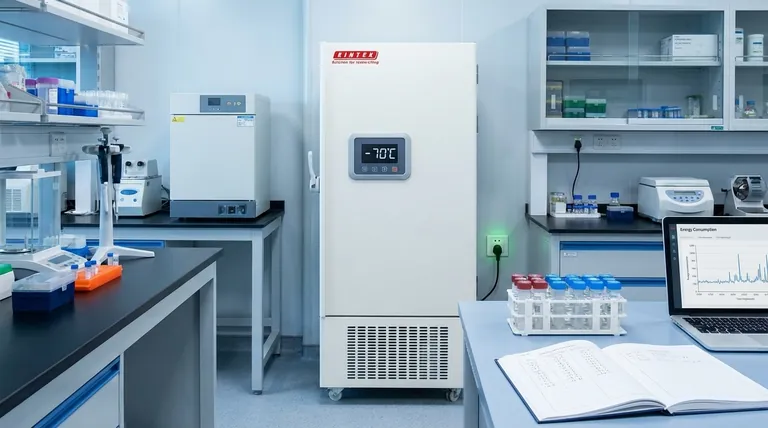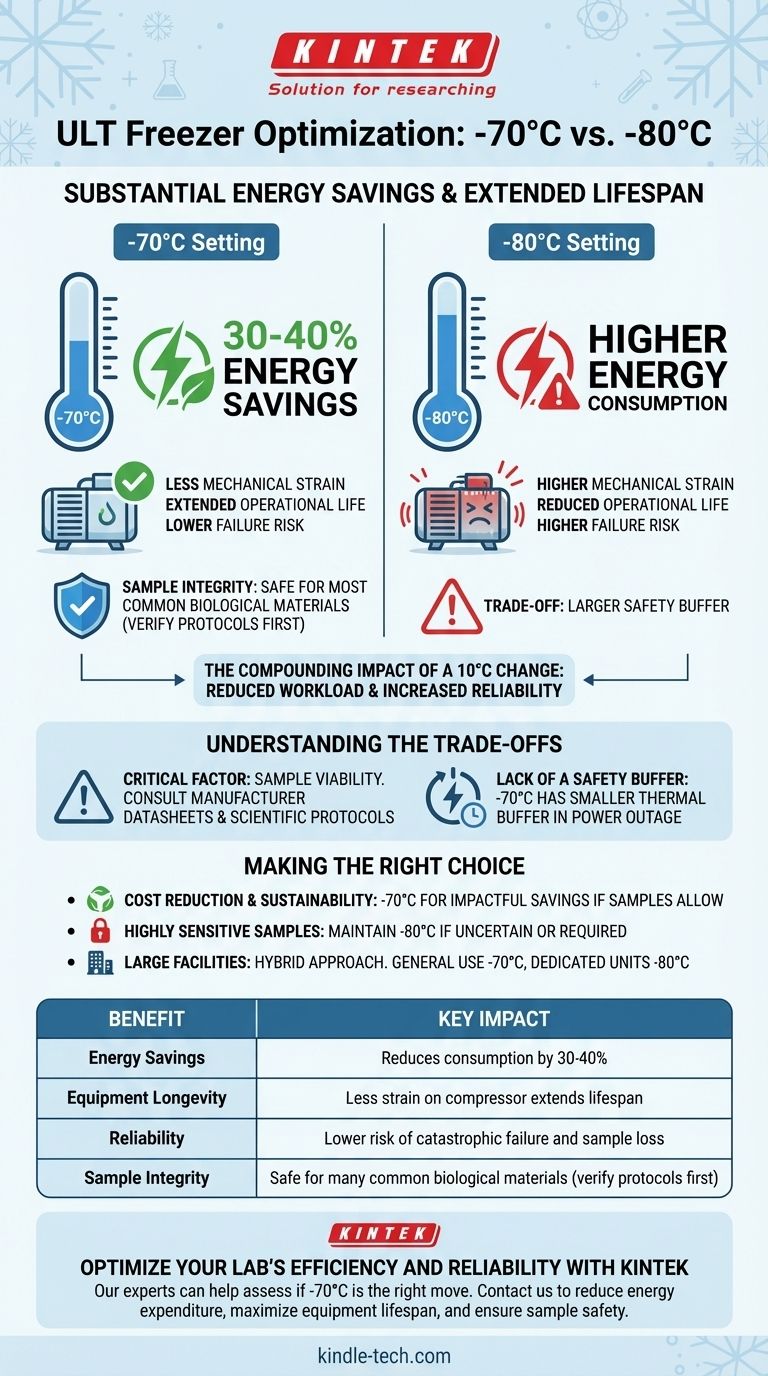The primary benefits are substantial energy savings and extended equipment lifespan. Shifting an ultra-low temperature (ULT) freezer from the common -80°C setting to -70°C can reduce energy consumption by 30-40%. This adjustment also lessens the mechanical strain on the freezer's cooling system, which prolongs its operational life and reduces the risk of costly failures.
Shifting your ultra-low temperature freezer from -80°C to -70°C is not just a minor adjustment; it's a strategic decision that directly reduces operational costs and mechanical strain without compromising the integrity of most common biological samples.

The Compounding Impact of a 10°C Change
While 10 degrees may seem like a small difference, at these extreme temperatures, it has a significant effect on the physics of cooling. The freezer must constantly fight against the ambient room temperature, and every degree of difference adds to the workload.
Drastic Reduction in Energy Consumption
A ULT freezer is one of the most energy-intensive pieces of equipment in a laboratory. The compressor must work significantly harder to maintain the temperature gradient between -80°C and the room than it does for -70°C.
This reduced workload directly translates into energy savings of 30-40%, a substantial reduction in operational costs, especially for institutions running multiple units.
Increased Equipment Longevity
The single most common point of failure in a ULT freezer is the compressor system. It is under constant, high stress to maintain these ultra-low temperatures.
By setting the target temperature to -70°C, you reduce the overall strain on the compressor and other cooling components. This directly contributes to a longer lifespan for the freezer and fewer maintenance calls.
Lower Risk of Catastrophic Failure
Equipment that is under less stress is inherently more reliable. A freezer running at -70°C is less likely to suffer a sudden, catastrophic compressor failure.
This increased reliability means less equipment downtime and, most importantly, a reduced risk of losing valuable and often irreplaceable samples due to a temperature breach.
Understanding the Trade-offs: When -80°C is Non-Negotiable
The decision to change the setpoint is not purely financial or mechanical. The primary consideration must always be the integrity of the materials being stored.
The Critical Factor: Sample Viability
Before making any changes, you must confirm the required storage temperature for your specific samples. While many common biological materials (like DNA, RNA, and many proteins) are stable at -70°C, others are not.
Always consult manufacturer datasheets or established scientific protocols. The preservation of your research materials is the top priority.
Lack of a Safety Buffer
A freezer set to -80°C has a slightly larger thermal buffer. In the event of a power outage or a door being left ajar, it will take longer for the internal temperature to rise to a critical point (e.g., -50°C) compared to a unit starting at -70°C.
For extremely sensitive or high-value samples, this extra buffer period could be crucial.
Making the Right Choice for Your Lab
This adjustment is a powerful tool for efficiency, but it must be applied with careful consideration for the samples being stored.
- If your primary focus is cost reduction and sustainability: Setting your freezer to -70°C is one of the most impactful changes you can make, provided your stored materials are verified to be safe at this temperature.
- If you are storing highly sensitive or irreplaceable samples: You must verify the specific storage protocol. If the requirement is explicitly -80°C, or if there is any doubt, you should not change the setting.
- If you are managing a large facility with multiple freezers: Consider a hybrid approach. General-purpose freezers can be set to -70°C, while dedicated units are maintained at -80°C for specific materials that require it.
Ultimately, this adjustment empowers you to operate a more efficient and reliable lab by aligning your equipment's performance with precise scientific needs.
Summary Table:
| Benefit | Key Impact |
|---|---|
| Energy Savings | Reduces consumption by 30-40% |
| Equipment Longevity | Less strain on compressor extends lifespan |
| Reliability | Lower risk of catastrophic failure and sample loss |
| Sample Integrity | Safe for many common biological materials (verify protocols first) |
Optimize your lab's efficiency and reliability with KINTEK.
As your partner in laboratory equipment and consumables, we understand the critical balance between operational cost, equipment performance, and sample integrity. Our experts can help you assess if adjusting your ultra-low temperature freezers to -70°C is the right strategic move for your specific samples and workflows.
Let KINTEK provide the solutions and support you need to:
- Significantly reduce your energy expenditure.
- Maximize the lifespan of your valuable equipment.
- Ensure the safety and integrity of your research materials.
Contact our lab equipment specialists today for a personalized consultation to enhance your lab's sustainability and performance.
Visual Guide

Related Products
- 158L Precision Vertical Ultra Low Freezer for Laboratory Applications
- 58L Precision Laboratory Ultra Low Temperature Upright Freezer for Critical Sample Storage
- 508L Advanced Vertical Ultra Low Temperature Freezer for Critical Laboratory Storage
- 938L Vertical Ultra Low Temperature Freezer for Advanced Laboratory Storage
- 808L Precision Laboratory Vertical Ultra Low Temperature Freezer
People Also Ask
- What are the common applications of ultra-low temperature freezers? Preserve Your Most Valuable Samples
- In what fields are ultra low temperature freezers most commonly used? Essential for Biomedical, Clinical, and Research Labs
- What advantages do ultra-low temperature freezers offer? Ensure Long-Term Sample Integrity and Reliability
- How do Ultra-Low Temperature freezers ensure the integrity of microbiological samples? Maintain Stability for Critical Research
- Where are ultra low temperature freezers commonly used? Essential for Labs, Hospitals, and Biotech



















